Photos, art and poems are reprinted from the historical collection of documents and materials of the Lewis H. “Dude” Larsen and Dot Larsen family, with permission from their daughter Bette L. Stanton of Moab, historian and co-author of “Roadside Art, Wisdom and Humor of the Old West,” and other books.
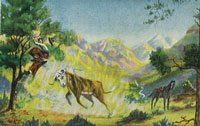
ROUGH RANGE
Wranglers were wise to behaviors of agitated animals and worked fast and efficiently when rounding up cattle for branding. Unfortunately, after cowboy Tom Larsen roped and tied this steer to his saddlehorn, the rope snapped, the steer snorted, and Tom had a pair of long horns bearing down on him. He managed to scamper up the only tree within short range just in time to avoid being impaled. His son, cowboy artist Dude Larsen, memorialized the moment in a painting and poem in 1939.
Where the range is rough and the cattle wild
A cowboy’s life is never mild
For many a critter just like this steer |
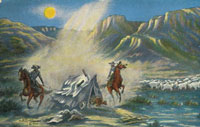 RANGE FEUD RANGE FEUD
In 1940, painter L.H. “Dude” Larsen illustrated a classic prank pulled by cattle- and sheepherders butting heads over rangeland along the Colorado-Utah border in the late 1800s and early 1900s. His classic western painting depicts two cowboys with 12-15 feet of rope tied to their saddlehorns and strung between them, which was then used to fell another herder’s tent in the night. According to lore, one sheepman got wise and set up his tent over a cedar tree stump which caught the rope and when the horses lurched, the cowboys went flying. They were more cautious after that.
|
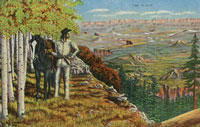 THE SCOUT THE SCOUT
Of more than 90 paintings the “Cowboy Artist” and his wife Dot produced, some 75 were reproduced and sold as postcards up until the early 1950s. The duo had distinctive styles of painting, and although the first card published was painted by Dot Larsen, the back of the card states the image was “taken from an original oil painting by the noted cowboy artist and poet, L.H. “Dude” Larsen. Family suggests it may have been a printing error, as this was one of Dot’s favorite artworks. It was used in a PBS documentary in 1998 on the early history of southeastern Utah.
|
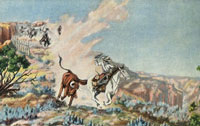 TRAPPING WILD CATTLE TRAPPING WILD CATTLE
L.H. “Dude” Larsen sketched a scene of “a true life experience from 1884” onto butcher paper, based on an incident where a wild cow charged at his Uncle Amasa Larsen at Big Flats, a mesa overlooking the Green and Grand (now Colorado) rivers. Using artist’s license, Dude depicted a steer chasing his father, Tom, who was helping Amasa round up wild cattle into a 3-sided corral where the canyon rim served as an invisible fence for the fourth side. Tom related that he fired above the animal to try to stop it, but precariously near the rim, he finally had to kill the crazed cow. The episode inspired a painting and one of Dude’s humorous poems.
The canyon is deep.
The rim is high;
The end is near
For you or I.
I’ve one shell left,
Now will it be
Death, for you
Or for us three.
For if perchance
This shot should fail
We’ll all go over the rim to ----
Well. We’d never get back to tell the tale.
|
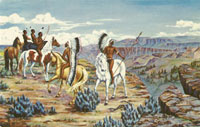 THE SIGNAL THE SIGNAL
Dot Larsen imagined what an Indian war party would look like and in 1945 painted a scene depicting hostile Utes readying for an attack on white folks. Her daughter, Bette Stanton, remembers that Dot worried about the natives, especially during the Black Hawk War in Utah, when the Ute Tribe was ushered by U.S. military onto the Uintah-Ouray Reservation.
|
Casually referred to by family and friends as Dude and Dot, they wereanambitious and talented couple whose lives were rooted in ranching. Lewis H. “Dude” Larsen was born in 1909 at Professor Valley Ranch northeast of Moab near the Colorado River. Dorothy “Dot” Robb, who married Dude in 1932, came from the Serpents Trail Ranch near Fruita, Colorado.
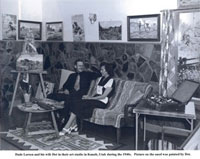
Both were essentially self-taught artists. Their favored medium: oil paints. Dude also wrote many poems to accompany his paintings, and for awhile, Dot penned romance novels but quit after her attempts failed to attract a publisher, according to her oldest daughter, Bette Larsen Stanton of Moab.
While many older residents of Moab and surrounding towns may remember “The Cowboy Artist” and his wife Dot, Stanton has gone to great lengths over the years to keep their story alive. Stanton, born at Serpents Trail Ranch (now Colorado State Park), was the first of the Larsens’ four children.
A historian and author herself, Stanton created an exhibit of her parents’ works for a special exhibit in 2003 at the Dan O’Laurie Museum of Moab, and wrote a small pamphlet to accompany the exhibit. Due to her efforts, a section of the Western Heritage Film Museum at Red Cliffs Lodge was also dedicated for display of the Larsen works and life story when Grand County moved its movie memorabilia to the main lodge of the resort in 2002-03.
Visitors to the county’s film museum, about 14 miles upriver along Utah Highway 128, are admitted free of charge.
Stanton remembers as a little girl watching how brushstrokes created images she recognized in everyday life of ranching and roaming the mountains and canyons of southeastern Utah and the Grand Canyon, where the family lived on income from Dude’s paintings during the Great Depression.
“I think what was neat was every time they painted I’d ask what they were painting, and they’d tell me, and that they were doing it so their descendants would know their story. The most important thing to my folks was they knew it was the end of the real Old West, and they wanted us to know how it was,” Stanton said.
In 1938, Dude acquired a loan to make a business out of his art and the family established a trading post and art studio in Kanab, later buying a hotel and café. In Kanab, Dot began painting to keep up with the demand for their western images reproduced as postcards. Stanton noted that her parents netted about $30,000 annually in those years, and she would haul the postcard shipments to the post office in her little red wagon.
Stanton’s grandparents, Mads and Elizabeth Larsen had joined the Church of Jesus Christ of Latter-day Saints (LDS, the Mormons) in 1855-56, after immigrating to America from Denmark. With one daughter, they crossed the Plains with one of the Mormon handcart companies. In compliance with a church custom that allowed plural marriage in those days, Mads Larsen took a second wife, Jane Bishop from England. With her, Larsen produced seven more children, among them Dude’s father, Mads Thomas “Tom” Larsen, born in 1869. It was the second marriage that was the lineage of “The Cowboy Artist” whose range and paintings encompassed the classic West of this area from Professor Valley up to the Bookcliff Mountains, and from Westwater Creek to Big Flats across to the La Sal Mountains.
It was a vast territory to ride, and a breathtaking country to paint.
Eventually, the artistic duo split up. Dude remarrried and took up ranching with his new wife in Colorado. Dot united with her first child Bette, whose children had grown, and they traveled extensively, ultimately settling in Moab in the 1980s, where Dot’s brother Nate lived. She died at 82 in Moab. Dude passed away at Valley Park Ranch in Colorado in 1997. He was 88.

|

 RANGE FEUD
RANGE FEUD THE SCOUT
THE SCOUT TRAPPING WILD CATTLE
TRAPPING WILD CATTLE THE SIGNAL
THE SIGNAL 
